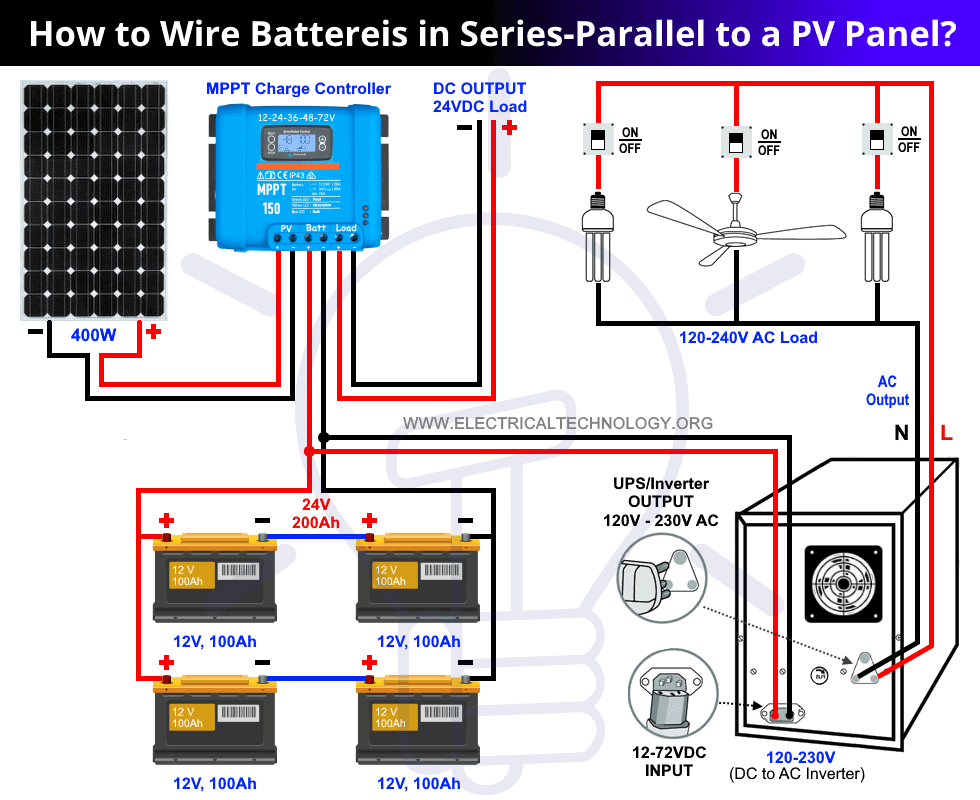How to Wire Batteries in Series-Parallel to a Solar Panel?
Series-Parallel Connection of Batteries to the PV Panel
This is another possible wiring connection of series parallel combination of batteries connected to the solar panels. As we may connect the solar panels as well as batteries in series, parallel and combo of series-parallel configuration. In today’s post, we will show the series-parallel connection of batteries to the solar panels, charge controller, DC and AC load points.
Suppose, we have to connect a single or multiple solar panels to the 4 numbers of batteries each of 12V and 100Ah. The possible connection for this arrangement (series-parallel) is 24V DC system.
The main purpose of series-parallel connection of batteries is to double up the voltage level as well as storage power (charge capacity) for later use. This is because series connection only increases the level of voltage (while current remains same) and parallel connection increases the amperes (while voltage level remains same). So we get the advantages of both connections i.e. increase both the level of voltage as well as amperage capacity.
Related Posts:
- How to Wire Batteries in Series to a Solar Panel and UPS?
- How to Wire Batteries in Parallel to a Solar Panel and UPS?
Voltage & Current in Series-Parallel Connected Batteries
Suppose we have 12V, 100Ah batteries connected in series-parallel connection.
A set of two batteries connected in series
12V + 12V = 24V. ….. (Voltage is additive in series connection)
100Ah = 100Ah = 100Ah ….. (Current is same in series connection).
Now, we have two sets of series connected batteries. If we connected these two set in parallel:
24V = 24V = 24V ….. (Voltage is same in parallel connection)
100Ah + 100Ah = 200Ah ….. (Current is additive in parallel connection).
Overall, we got 24V, 200Ah from four batteries each of 12V and 100Ah i.e. we doubled both the current and voltage capacity of batteries e.g voltage from 12V to 24V and battery ampere hour rating from 100Ah to 200Ah.
Related Posts:
- How to Design and Install a Solar PV System? With Solved Example
- A Complete Note on Solar Panel Installation with Calculation & Examples
To do this wiring, connect the first two batteries separately in series and do the same for the remaining two batteries. This way, we will have two sets of series connected batteries. Now connect these two sets of series connected batteries in parallel connection as shown in the following fig. Now, we are having four 12V, 100Ah batteries connected in series-parallel configuration.
You may proceed to connect these batteries to the UPS/inverter (which is farther connected to the AC load) to power up the AC load (120V/230V AC). In addition, connect the same battery configuration to the solar charge controller which is farther connected to the PV panel.
The following solar panel and battery wiring diagram shows how to wire a 24V Solar Panel to four 100Ah, 12V batteries in series-parallel configuration with an automatic inverter system.
The solar panel(s) will charge the battery as well as power up the AC load during the day (normal shun shin). The stored power in the batteries can be used to power up the AC load during night (or shading) when no power is available from the photovoltaic panel. The whole process is automatic due to auto UPS wiring i.e. no need to install an auto or manual changeover / ATS switch.
Related Posts:
- How to Wire Solar Panel to 120-230V AC Load and Inverter?
- How to Wire Solar Panel to 12V DC Load and Battery?
Good to know:
- Current is the same while voltage is additive in series connection.
- Current is additive while voltage is the same in parallel connection.
- Only same rated batteries can be connected in series, parallel or series parallel connection.
- A 12V battery can only be connected (series, parallel or series-parallel) with another 12V battery.
- A 12V battery should not be connected (in series, parallel or series parallel) to a 6V or 24V battery.
Related Solar Panel Wiring & Installation Diagrams:
- How to Wire Solar Panel & Batteries in Series for 24V System?
- How to Wire Solar Panel & Batteries in Parallel for 12V System?
- How to Wire Solar Panels & Batteries in Series-Parallel Connection?
- How to Wire Solar Panels in Series & Batteries in Parallel? 12/24/48V System
- How to Wire Solar Panels in Parallel & Batteries in Series? 24V System
- Basic Components Needed for Solar Panel System Installation
- How Much Watts Solar Panel You Need for Home Appliances?







